There was quite a thread on ditch and bank mowers last fall - see Offset Flail Ditch Bank Mower
As a result of that discussion I ended up buying a Peruzzo Fox Cross 1600 ditch and bank flail mower. I've now had a chance to use it a bit and prompted by a private message asking about it I thought it is time to offer a review.
I decided on this brand because of it's size, weight, and amount of offset offered. My tractor is a John Deere 870, rated at 28 HP and about 2600 lb. Our property is fairly steep, with around four acres we mow, twice a year:
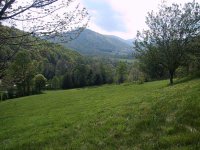
Because of the hillside I have the rear tires set all the way out, which presents a problem when you want a ditch and bank mower to be able swing up or down to cut a ditch or bank outside the rear tire. This model seemed to have about the farthest reach of those I looked at. I was also concerned about the weight of the unit when lifted off to the side, given the relatively light weight of my tractor, especially on the hills. This model was one of the lighter ones I found in a five-foot mower. With 250 lb of suitcase weights on the front you know it's there, but the tractor does handle it pretty well. Still, I'm careful when lifting it on a side hill.
There seems to be only one Peruzzo dealer in the US, Iowa Farm Equipment, at Iowa Farm Equipment. Buying an expensive toy like this online isn't ideal, but they made it pretty painless. Hint, deal with them by phone, rather than buying from them on Ebay or off their direct-sales website at farmattachments.com
Getting it delivered, even with lift-gate service from the trucking service was interesting. He was able to get it on the lift-gate and to the ground, but I had to drag it off the lift-gate with my tractor.
Construction quality of the machine is impressive. Nice fit and finish all around. Little things, like extension tubes on the grease fittings that are hard to reach, and a plastic edging around the belt cover where it fits against the frame, are nice touches.
It requires two hydraulic connections, one with float, to control the offset and vertical angle of the mower head. I used the outlets for my FEL, which is fine because I remove it when mowing anyway. The cylinders are small so this makes any movement pretty jumpy, especially at PTO engine speed. I'm getting better at dealing with that. The dealer included extension hoses to reach the FEL connections in their quote, which was helpful. There was an issue with the coupling between the factory hoses and the extensions leaking, but they sent replacement seals that fixed that issue.
Using this arrangement takes some getting used to. You are supposed to keep the up-down angle cylinder in float. But that means before you lift the unit with the 3-point lever you have to remember to pull the FEL joystick out of float and actually pull the slack out of that cylinder. I'm getting better at that too.
The 3-point hitch is an awkward cat 1/2 arrangement. It uses cat 2 size pins in a yoke, with the smaller cat 1 pins projecting inwards, which you can kind of see in the photo below. The way it's mounted the cat 1 pins can't be removed while hitched up, so you have to loosen the sway bars enough to let the 3-point arms swing in off the pins to hitch or un-hitch it. It works, but it's painful. Keeping it on a dollie helps:
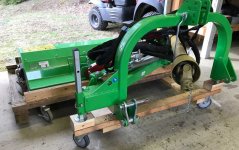
So, how does it work? As a ditch and bank mower, it's claim to fame, it's great! Here's a shot of my testing it on one of my banks last winter:
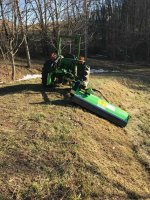
This bank is too steep to cut across with the rotary cutter, so I had to make repeated steps backing up it, a total pain. With this I can make one pass from the top then cut the rest from below with the mower extended up the bank. Here's how it looks:
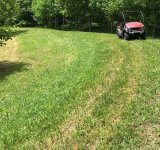
I also have a ditch with a steep bank into the field:
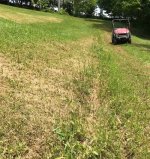
With this I can make one pass to cut the road side, then with the tire in the ditch cut a pass on the far side of the ditch, then a second pass with the tractor part way up the hillside. That gets me far enough to reach from above with the mower offset down the slope.
Here's an even steeper bank being cut:
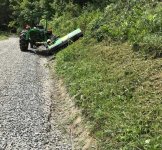
In addition to doing ditch and bank work I hoped to use it to mow the field, replacing my Bush Hog brand rotary cutter. In this application it's rather more a mixed bag. I had hoped to solve two issues that I have with the rotary cutter -- leaving heavy windrows since I cut only twice a year, and failing to cut what the tractor tires run over so that pops up an hour later.
Clearly the flail solves the windrow issue. It leaves a thin cover of well-cut greens across the width of the cut. It's not noticeably better at picking up what the wheels run over. But, running in offset mode that's mostly solved since most of the time I don't have to run over un-cut material.
It's also pretty convenient when cutting under trees using the offset, and we have lots of trees in and around the field (see first photo above).
But the cut quality, leaving aside what the wheels run over, is clearly better with the rotary cutter. The flail (with hammer knives) does fine in grass, but not so well with stemmy weeds. It leaves a lot of six to twelve inch stems standing:

Here's a shot of the sort of weeds it doesn't like:
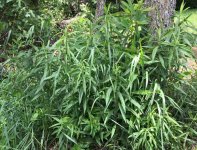
Also, it uses a lot more fuel. I've never used two plus full tanks to mow this field before. We have a lot of little awkward corners that require backing and forthing, and the flail doesn't cut in reverse. So it takes twice as long to cut these places. It doesn't back into really tight spaces between trees as well as the rotary.
I'm also concerned about the amount of maintenance. After one use the blades look pretty beat up. Part of that is from setting it too low for a while trying to improve the cut quality and getting in the rocks and dirt, but the thought of having to sharpen all those knives is painful.
So... I'll probably keep using it for the field, but I'm not ready to sell my rotary cutter yet.
As a result of that discussion I ended up buying a Peruzzo Fox Cross 1600 ditch and bank flail mower. I've now had a chance to use it a bit and prompted by a private message asking about it I thought it is time to offer a review.
I decided on this brand because of it's size, weight, and amount of offset offered. My tractor is a John Deere 870, rated at 28 HP and about 2600 lb. Our property is fairly steep, with around four acres we mow, twice a year:

Because of the hillside I have the rear tires set all the way out, which presents a problem when you want a ditch and bank mower to be able swing up or down to cut a ditch or bank outside the rear tire. This model seemed to have about the farthest reach of those I looked at. I was also concerned about the weight of the unit when lifted off to the side, given the relatively light weight of my tractor, especially on the hills. This model was one of the lighter ones I found in a five-foot mower. With 250 lb of suitcase weights on the front you know it's there, but the tractor does handle it pretty well. Still, I'm careful when lifting it on a side hill.
There seems to be only one Peruzzo dealer in the US, Iowa Farm Equipment, at Iowa Farm Equipment. Buying an expensive toy like this online isn't ideal, but they made it pretty painless. Hint, deal with them by phone, rather than buying from them on Ebay or off their direct-sales website at farmattachments.com
Getting it delivered, even with lift-gate service from the trucking service was interesting. He was able to get it on the lift-gate and to the ground, but I had to drag it off the lift-gate with my tractor.
Construction quality of the machine is impressive. Nice fit and finish all around. Little things, like extension tubes on the grease fittings that are hard to reach, and a plastic edging around the belt cover where it fits against the frame, are nice touches.
It requires two hydraulic connections, one with float, to control the offset and vertical angle of the mower head. I used the outlets for my FEL, which is fine because I remove it when mowing anyway. The cylinders are small so this makes any movement pretty jumpy, especially at PTO engine speed. I'm getting better at dealing with that. The dealer included extension hoses to reach the FEL connections in their quote, which was helpful. There was an issue with the coupling between the factory hoses and the extensions leaking, but they sent replacement seals that fixed that issue.
Using this arrangement takes some getting used to. You are supposed to keep the up-down angle cylinder in float. But that means before you lift the unit with the 3-point lever you have to remember to pull the FEL joystick out of float and actually pull the slack out of that cylinder. I'm getting better at that too.
The 3-point hitch is an awkward cat 1/2 arrangement. It uses cat 2 size pins in a yoke, with the smaller cat 1 pins projecting inwards, which you can kind of see in the photo below. The way it's mounted the cat 1 pins can't be removed while hitched up, so you have to loosen the sway bars enough to let the 3-point arms swing in off the pins to hitch or un-hitch it. It works, but it's painful. Keeping it on a dollie helps:

So, how does it work? As a ditch and bank mower, it's claim to fame, it's great! Here's a shot of my testing it on one of my banks last winter:

This bank is too steep to cut across with the rotary cutter, so I had to make repeated steps backing up it, a total pain. With this I can make one pass from the top then cut the rest from below with the mower extended up the bank. Here's how it looks:

I also have a ditch with a steep bank into the field:

With this I can make one pass to cut the road side, then with the tire in the ditch cut a pass on the far side of the ditch, then a second pass with the tractor part way up the hillside. That gets me far enough to reach from above with the mower offset down the slope.
Here's an even steeper bank being cut:

In addition to doing ditch and bank work I hoped to use it to mow the field, replacing my Bush Hog brand rotary cutter. In this application it's rather more a mixed bag. I had hoped to solve two issues that I have with the rotary cutter -- leaving heavy windrows since I cut only twice a year, and failing to cut what the tractor tires run over so that pops up an hour later.
Clearly the flail solves the windrow issue. It leaves a thin cover of well-cut greens across the width of the cut. It's not noticeably better at picking up what the wheels run over. But, running in offset mode that's mostly solved since most of the time I don't have to run over un-cut material.
It's also pretty convenient when cutting under trees using the offset, and we have lots of trees in and around the field (see first photo above).
But the cut quality, leaving aside what the wheels run over, is clearly better with the rotary cutter. The flail (with hammer knives) does fine in grass, but not so well with stemmy weeds. It leaves a lot of six to twelve inch stems standing:

Here's a shot of the sort of weeds it doesn't like:

Also, it uses a lot more fuel. I've never used two plus full tanks to mow this field before. We have a lot of little awkward corners that require backing and forthing, and the flail doesn't cut in reverse. So it takes twice as long to cut these places. It doesn't back into really tight spaces between trees as well as the rotary.
I'm also concerned about the amount of maintenance. After one use the blades look pretty beat up. Part of that is from setting it too low for a while trying to improve the cut quality and getting in the rocks and dirt, but the thought of having to sharpen all those knives is painful.
So... I'll probably keep using it for the field, but I'm not ready to sell my rotary cutter yet.
Last edited:

